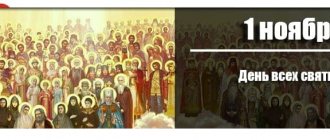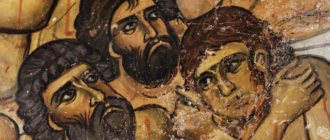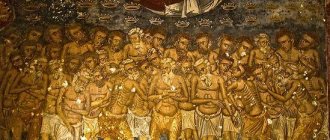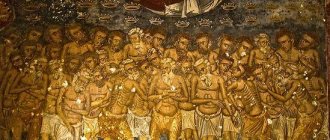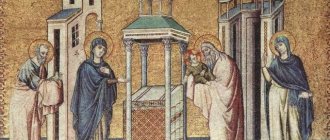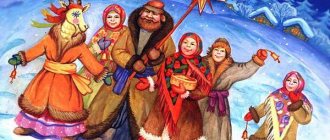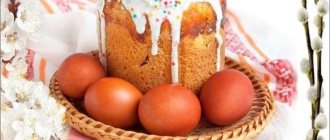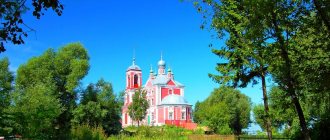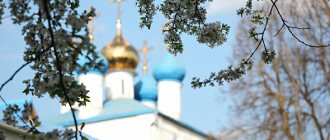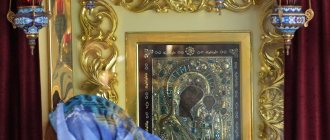Lives of the 40 Martyrs of Sebaste
The Forty Martyrs of Sebaste are the saints of the first centuries of Christianity. Their lives left a deep mark on the history of the faith of Christ. In 313, the Roman Emperor Saint Constantine the Great gave Christians freedom. But there was also a second ruler in Rome - Licinius. An ardent pagan, he not only planned to resume the persecution of believers in Christ, but also prepared to betray Constantine and become the sole emperor of Rome. The traitor decided to start the massacres with the military, among whom there were many followers of the Savior.
In the city of Sebastia there was just one of these - Christian - troops. Under the command of the pagan Agricolaus there was a whole squad of Christians - forty warriors, glorified by many victories. At the instigation of Licinius, Agricolaus tried to force them to sacrifice to the pagan gods, but they refused, for which they were thrown into prison. There the soldiers prayed to Christ, and it was revealed to them that “he who endures to the end will be saved.”
The next morning, the insidious Agricolaus again tried to persuade the army to renounce the Savior. But he failed the second time. Christians were again thrown into prison. A week later they were tried. The brave warriors answered the pagan court firmly: “Take not only our military rank, but also our lives, for us there is nothing more precious than Christ God.”
They wanted to stone the martyrs, but the cobblestones did not reach them - as if the Holy Spirit himself was protecting them from death. And again they imprisoned Christians. During prayer they heard: “He who believes in Me, even if he dies, will live. Be bold and do not be afraid, for you will receive imperishable crowns.”
Fresco of the temple of the Church of the Blessed Virgin Mary Asinu, Cyprus, 12th century. Photo by Maria Cherkashina
And so, when a frosty winter day arrived, the martyrs were led to a local lake and left there in custody, naked, right on the ice, where cold water splashed. A bathhouse was lit nearby so that in the agony of death the soldiers would renounce Christ and exchange Him for warmth... But only one of the sufferers could not stand it and ran to the bathhouse - and immediately fell dead in front of it.
In the morning, when one of the guards woke up, he saw shining halos above the heads of each of the thirty-nine Christians. Realizing why there were only 39 crowns, he exclaimed: “And I am a Christian!” — took off his clothes and stood next to the soldiers. In the morning, the soldiers and the guard were taken out of the lake and their legs were broken. Then their bodies were taken in chariots to the fire and burned.
When three days had passed after the execution, Bishop Peter of Sebastia saw the holy warriors in a dream - he was told to bury their remains. Together with his assistants, he collected the holy relics one by one and interred them with prayer.
Iconography
In the bell tower of the Church of the Holy Sepulchre, there is the Church of the Forty Martyrs of Sebaste, and there is an icon depicting the plot of the legend about the warriors. Some martyrs stand in the water, others are tormented on the shore.
In the foreground is Meletios on his way to the bathhouse, with a guard standing outside the door. To the left, a white city spreads out in the greenery; a little higher up is a detachment of warriors in armor, with shields and spears. But they stand with their backs to what is happening in the water and on the shore.
In Berlin, the Bode Museum houses a 10th-century Byzantine bas-relief. The faces and poses of the forty martyrs are not made according to a template, therefore they do not depersonalize, but convey the character of each of them.
There are two types of images of the Saints of Sebastia:
- episode on the river;
- individual images on medallions.
Personal icons often depict Saint Kirion of Sebaste as the eldest of forty warriors - in a red or blue cloak, with a cross in his right hand.
Temple of the 40 Martyrs of Sebaste
The Temple of the 40 Martyrs of Sebaste is located in Moscow near the Novospassky Monastery. The exact address of the temple: Dinamovskaya street, building 28.
In 1640, here on Taganka, Tsar Mikhail Fedorovich Romanov, the first tsar of this illustrious dynasty, determined that masons - the builders of the walls of the monastery and the monastery's Transfiguration Cathedral - would live here.
When the construction work ended, the masons did not go anywhere and settled here on Taganka. It was their craft that gave the name to two neighboring streets - Big and Small Masons. And soon, in 1645, not far from the entrance to the monastery, a new temple grew up - the 40 Martyrs of Sebaste.
Fresco of the temple of the Church of the Blessed Virgin Mary Asinu, Cyprus, 12th century. Photo by Maria Cherkashina
What do martyrs ask for?
The main issue that the prayer to the forty Sebaste martyrs helps resolve is doubt in faith. Everyone who reads or remembers the feat of the warriors is like Aglaia, watching from the shore - thirty-nine holy crowns are lit for him in the dark. All that remains is to renounce your vices and take the fortieth.
The holy martyrs are turned to for help in the following situations:
- in testing fortitude;
- in defense of right principles;
- if necessary, humbly endure a difficult period.
Sebastian warriors are a symbol of the fact that all trials and troubles end, and grace awaits the strong in spirit. Forty martyrs come to the aid of those who are literally freezing to death. Metropolitan Joseph (Chernov) of the Russian Orthodox Church testified to the miracle.
In his youth, the clergyman did not attach importance to the feat of the Sebastians, leaning towards their mythical nature. But, finding himself in the dungeons of the Gestapo, in a cell with windows without glass, in the cold and in only a cassock, Father Joseph understood the despair and severity of their situation.
In repentance, he turned to the holy warriors, and soon felt that he had warmed up. And then the cell door opened, and friends handed him warm clothes, food and the Holy Gifts.
Prayers to the Holy Forty Martyrs of Sebaste
First prayer
About the holy glory of the passion-bearers of Christ, the fourty, in the city of Sebastia, for the sake of Christ, who courageously suffered, through fire and water, and as the friends of Christ entered into the peace of the Heavenly Kingdom, have great boldness to intercede with the Most Holy Trinity for the Christian race: especially for those who honor your holy memory , and calling you with faith and love. Ask the all-merciful God for forgiveness of our sins and correction of our lives, so that in repentance and unfeigned love for each other, having lived with each other, we will boldly appear before the terrible judgment seat of Christ, and through your intercession we will appear at the right hand of the righteous Judge. To her, saints of God, be our protectors from all enemies, visible and invisible, so that under the shelter of your holy prayers we will get rid of all troubles, evils and misfortunes until the last day of our life, and thus we will glorify the great and venerable name of the all-powerful Trinity, the Father and the Son and the Holy Spirit, now and ever and unto ages of ages. Amen.
Second prayer
O passion-bearers of Christ, who courageously suffered in the city of Sebaste, we earnestly resort to you as our prayer books and ask: ask the All-Bounteous God for forgiveness of our sins and correction of our lives, so that in repentance and unfeigned love for each other, having lived together, we will boldly present ourselves to the terrible judgment of Christ and through your intercession we will stand at the right hand of the Righteous Judge. To her, God's servants, awaken us, God's servants (names), protectors from all enemies visible and invisible, so that under the shelter of your holy prayers we will get rid of all troubles, evils and misfortunes until the last day of our life, and thus glorify the great and venerable name of the Almighty Trinity, Father and Son and Holy Spirit, now and ever and unto ages of ages. Amen.
Reverence
The day of remembrance of the Forty Martyrs of Sebaste in Orthodoxy is March 9/March 22. In honor of the holy warriors, restrictions during Lent are being eased. This is one of the most revered holidays, therefore, at the evening service in the church, Communion is celebrated with the Holy Gifts, consecrated at the previous liturgy.
The memorable date was established by the Bulgarian ruler Ivan II Asen in 1230. He fought with the Thessalonian emperor Theodore Komnenos Ducas. Ivan prayed to the forty Sebastian martyrs and won victory on March 9th. To glorify the holy intercessor warriors, the Bulgarian built a church in their honor. The temple is still located in the city of Veliko Tarnovo, the former capital of Bulgaria.
The Day of Remembrance of the Forty Martyrs of Sebaste is considered a holiday for all Orthodox men. Also, the memorable date coincides with the Slavic folk festival of magpies, associated with the arrival of spring and the return of larks and waders. For the holiday, baked goods are baked in the shape of birds. Baked “larks” symbolize the souls of martyrs flying to God.
The existence and veneration of the feast of the forty martyrs of Sebaste is known thanks to the sermons of the saints and brothers Gregory of Nyssa and Basil the Great. In their family, martyrs were revered saints. The parents of the saints are buried next to the resting place of the relics of the holy Cappadocian warriors.
On the day of remembrance of the Sebastian warriors, Christians prayed to the Albazin Icon of the Mother of God in gratitude for all the gifts that the Lord sends and women who dream of motherhood.
Icon of the 40 Martyrs of Sebaste
In the center of the icon of the 40 Sevastian martyrs we see the warriors themselves. They are standing on an icy lake - naked. Some support others, some are trying to somehow escape the frost - their figures are depicted in dynamics. Also on the icon we see the figure of the fortieth warrior, who retreated from faith in the Savior and rushed to the bathhouse, which the guards assigned to the martyrs specially melted for temptation. The face of the apostate is not written on the icon - it is a symbol of his betrayal.
In the lower corner of the icon, icon painters depict the guard Aglaiya. It was he who became the fortieth martyr in place of the apostate when he saw shining halos above the heads of the soldiers. Also on the icon is the image of the Savior, who overshadows the saints with a blessing gesture.
What is the meaning of the holiday
He highlights self-sacrifice and intolerance of betrayal, as evidenced by the tragic fate of the martyrs. To be saved, it was enough to renounce the faith, but they did not give in. I am sure that they are deliberately trying to push this holiday to the back rows. Some forces are not interested in such spiritual education. Life is an excellent example of devotion to everything one has. Not necessarily religion. For example, love for the Fatherland, language, culture,” says Alexander Kritsky.
Description of the icon
The icon depicts 40 men, barefoot and undressed, wearing only loincloths. Below them is a frozen lake. Warriors of different ages, some already have substantial beards, others are very young, with clean, hairless faces. Some, physically weak, can no longer stand. They are supported by stronger men.
At the top, 40 golden crowns float in the air. One is a little away from the rest. Below it is a bathhouse and the back of a warrior is visible, rushing towards the warmth. There is also a guard, taking off his clothes and throwing himself into the lake, he is the fortieth. Above, against the backdrop of the starry sky, is the hand of God, protecting with the cover of the great martyrs suffering for the faith.
Some images depict a Christian woman supporting her son.
What not to do on March 22
Since Soroki is a major church holiday, in Rus' any work was prohibited on this day, including housework and gardening. Moreover, it was still too early to go out into the field, and the housewives tried to finish all the cooking the day before.
As on other days of Lent, on Forty and Forty, quarrels, arguments, swearing, and evil thoughts are strictly prohibited. It was believed that everything bad attracts trouble.
Also on this day, they tried not to scold children and not prohibit them from noisy games and fun. In addition, on this holiday it was impossible to sit at home, otherwise spring could pass by.
Lark cookie recipe
The dough was made with yeast, it had to be made elastic and well kneaded. They baked it in vegetable oil (for the sake of the strictness of Lent, they softened it a little), and brushed it with sweet, strong tea so that the cookies would brown well.
For the dough, we took two kilograms of flour, 50 grams of yeast, 250 grams of vegetable oil, a glass of sugar, half a liter of water, a little salt, and a handful of raisins. The dough was thoroughly kneaded, then rolled into a rope, which was divided into exactly forty parts. Each piece of the rope was folded into the shape of a bird, and a beak and tail were formed. The eyes were made from raisins.
The finished cookies were placed on a baking sheet greased with vegetable oil and left for about twenty minutes so that the dough rose a little. Then they greased the cookies with sweet strong tea and put them in the oven or oven. These cookies are baked for about twenty minutes at a temperature of approximately 180 degrees.
The finished cookies should be sprinkled with water and allowed to “rest” under a clean towel.
Cookies were given to children with the words:
“The larks flew in and sat on a head.”
The children not only ate cookies, but also crumbled them for the birds, uttering chants that would attract spring.
To protect against morning frosts, housewives in Soroka also baked forty small rye koloboks, which they threw from the windows to the birds for forty days.
Press service of the Committee on Natural Resources, Environmental Protection and Environmental Safety
Signs and sayings
- If the magpies are warm, forty days will be warm; if they are cold, expect forty cold mornings.
- On Soroka, day and night are measured and equal.
- What the Magpies look like, so do the Petrovkas.
- If the frost lasts forty days, then it will be warm in the summer.
- The frost that occurred on March 22 promises a harvest, especially millet.
- What is the weather like in Soroka, it will be like this for another forty days.
- Thunder is heard - for a hungry year.
- A warm wind promises a rainy summer.
- Jackdaws and magpies are found in large numbers, which means it will soon be warm.
- The seagull has flown in - soon the ice will melt, spring will begin, the lark has flown in - to the warmth, the finch - to the cold.
